
Sevilla is a station on Line 1 the Mexico City Metro. It is located in the Cuauhtémoc borough in the centre of Mexico City, on Avenida Chapultepec and Sevilla street. It serves colonias Roma and Juárez. Since 9 November 2023, the station has remained closed for modernization work on the tunnel and the line's technical equipment.

La Línea de la Concepción, often referred to simply as La Línea, is a municipality of Spain belonging to the province of Cádiz, Andalusia.

La Linea is an Italian animated series created by the Italian cartoonist Osvaldo Cavandoli. The series consists of 90 episodes, which were originally broadcast on the Italian channel RAI between 1971 and 1986. The background tune for the series was created by Franco Godi.
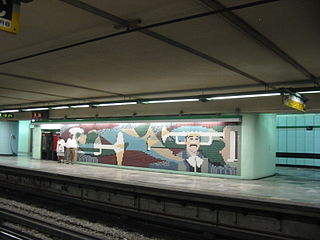
Garibaldi / Lagunilla is a station on the Mexico City Metro. It is a transfer station, serving both Lines 8 and B. It is the northern terminus of Line 8.
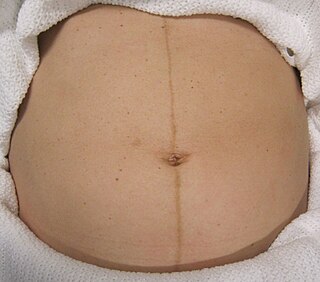
Linea nigra, denoted by its Latin translation "black line," colloquially known as the pregnancy line, manifests as a linear area of heightened pigmentation frequently observed on the abdominal region during pregnancy. Typically spanning approximately one centimeter in width, this brownish streak extends vertically along the midline of the abdomen, spanning from the pubis to the umbilicus. Variably, it may traverse from the pubis to the upper abdominal region.

Martín Carrera is a station on the Mexico City Metro. It is located at the borders of the Colonia Martín Carrera, Colonia 15 de Agosto, and Colonia Díaz Mirón districts in the Gustavo A. Madero borough, in the north of Mexico City. The station logo depicts bust of General Martín Carrera, a national hero who fought in the Mexican–American War of 1846–48.
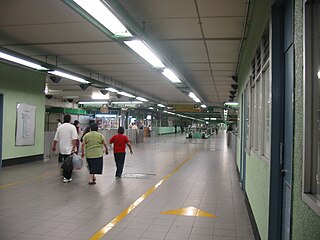
Salto del Agua is a metro (subway) station on the Mexico City Metro. It is located in the Cuauhtémoc borough in the center of Mexico City. Since 9 July 2022, the Line 1 station has remained closed modernization work on the tunnel and the line's technical equipment.

San Cosme is a station on Line 2 of the Mexico City Metro system. It is located in the Cuauhtémoc municipality of Mexico City, northwest of the city centre, on Avenue Ribera de San Cosme a few blocks before it becomes Calzada México-Tacuba. The southern exit leads to Colonia San Rafael while the Northern one leads to Colonia Santa María la Ribera. It is two blocks from the Mercado de San Cosme. In 2019, the station had an average ridership of 22,891 passengers per day.
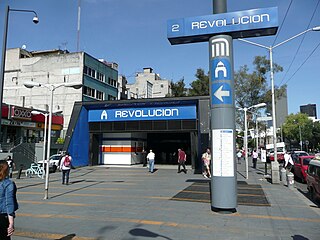
Revolución is a station on Line 2 of the Mexico City Metro system. It is located in the Colonia Tabacalera and Colonia Buenavista districts in the Cuauhtémoc borough of Mexico City, northwest of the city centre, on Avenida México - Tenochtitlan. It was first opened to the public on 14 September 1970.

Ermita is a station on Line 2 and Line 12 of the Mexico City Metro system. According to the Sistema de Transporte Colectivo, Ermita serves as a transfer station of Line 12. It is located in the Benito Juárez borough of Mexico City, directly south of the city centre on Calzada de Tlalpan.

Vallejo is a station along Line 6 of the Mexico City Metro. It is located in the Colonia Vallejo neighborhood of the Azcapotzalco borough of northwestern Mexico City.

San Joaquín is a station along Line 7 of the metro of Mexico City.
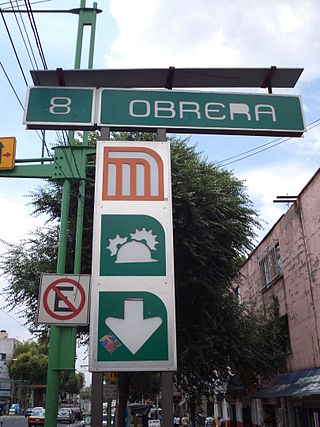
Obrera is a station along Line 8 of the metro of Mexico City. The station is situated on Eje Central Lázaro Cárdenas. The station's logo is a construction worker's helmet framed with two gears. The name obrera comes from the Colonia Obrera neighborhood where the station is located.

The Fiat Linea is a compact sedan produced by Fiat between 2007 and 2018. The sedan was released on 26 March 2007 at the Tofaş plant in Bursa, Turkey as a "world car" in developing countries. It is based on the Fiat Grande Punto. The Linea was designed by Fiat Style Centre and co-developed by Tofaş and Fiat do Brasil. Production in Turkey ended in 2016.

Abramites hypselonotus – known as the marbled headstander or the high-backed headstander – is a member of the family Anostomidae of the order Characiformes. Under normal fish classifying rules, the marbled headstander would be classified as a surface dweller. In reality marbled headstanders – like all headstanders – inhabit the middle and lower portions of the aquarium. In the wild, head standers are often found face down, tail up in narrow vertical rocky fissures.
Abramites eques, also known as headstander, picúo, or sardina, small teleost fish and is a member of the family Anostomidae of the order Characiformes. This South American species, like Abramites hypselonotus, adopts a head-down swimming posture due to its distinct feeding habit, which is a direct result of the locals that it frequents.

Chitala hypselonotus is a species of knifefish found in freshwater habitats in Borneo and Sumatra in southeast Asia.

Hypselonotus is a genus of leaf-footed bugs in the family Coreidae. There are about 12 described species in Hypselonotus.

Hypselonotus punctiventris, the spot-sided coreid, is a species of leaf-footed bug in the family Coreidae. It is found in Central America and North America.


















